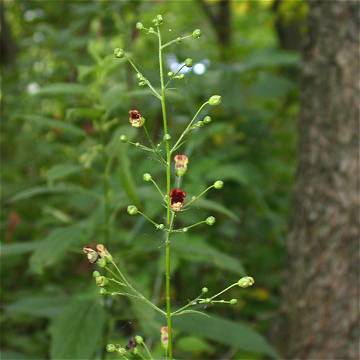

Scrophularia marilandica - (image 1 of 7)
Taxonomy
Family: Scrophulariaceae
Habitat
Clay and loam soils along fencerows, at the edges of woods, and disturbed open woods. Occasional in sandy woods.
Associates
Campanula americana, Carex blanda, Cryptotaenia canadensis, Eupatorium rugosum, Polygonatum canaliculatum, Polygonum virginianum, Prunus serotina, Prunus virginiana, Smilacina racemosa, Solidago ulmifolia, Tilia americana. In sandy woods with Aster azureus, Aster linariifolius, Carex pensylvanica, Comandra umbellata, Lithospermum croceum, Pteridium aquilinum, Quercus velutina, Rosa carolina, Vitis riparia.
Distribution
Quebec west to MN, south to SC and LA.
Morphology
Herbaceous perennial to 3 m high. Leaves opposite, blades mostly evenly serrate or serrate-dentate, the teeth mostly rounded or broadly tapering to an abruptly apiculate tip; leaf bases broadly rounded to mostly subcordate or cordate; petioles slender, not margined. Stems faces mostly grooved, not flat.
Inflorescence large, terminal, paniculiform, loosely and irregularly branched, tending to be pyramidal. Flowers zygomorphic. Corolla bilabiate, the upper lip directed forward, 5-8 mm wide, red-brown; 2-lobed, the lateral lobe of the lower lip also directed forward, the median lobe deflexed. Calyx regular, deeply saucer-shaped, divided to the middle into 5 broad, obtuse lobes. Stamens 4; sterile stamen brown or purplish, not greenish yellow, narrowly dilated, commonly longer than wide, situated under the upper corolla lip. Seeds angular, rugose, somewhat shiny, 4-7 mm long.
Notes
Flowers late June to mid October
Wetland indicator: Facultative Upland -
Also called Throatwort because it has been used to treat throat ailments.
References
Gleason, Henry A. and A. Cronquist. 1991. Manual of Vascular Plants of
Northeastern United States
and Adjacent Canada. Second Ed.
The New York Botanical Garden. Bronx, NY
Swink, F. and G. Wilhelm. 1994. Plants of the Chicago Region.
Indiana Academy of Science. The Morton Arboretum. Lisle, Illinois.
|
Michael Hough © 2005 |